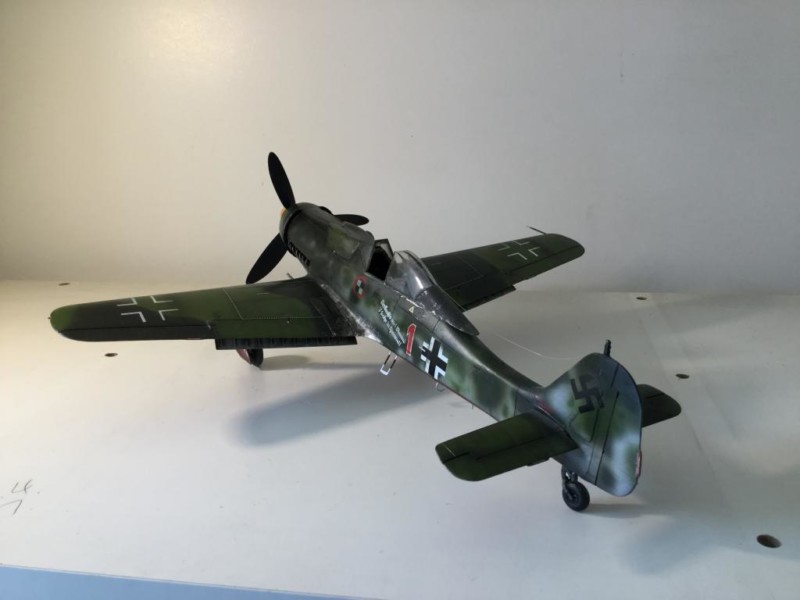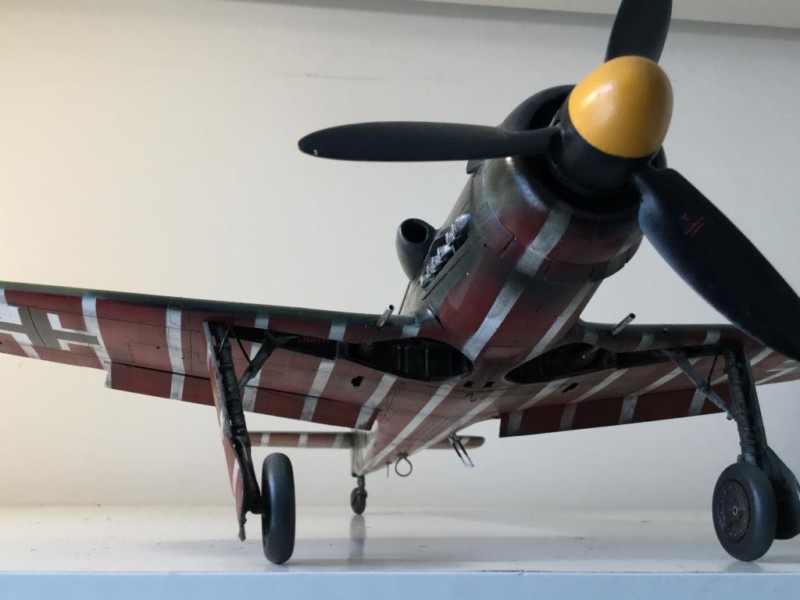Galland’s flying circus
I have always thought of the 'Dora' as a wonderfully elegant aircraft which was great counterpoint to it's brutal parentage, the pugnacious and acutely aggressive 'Butcher Bird' (which has it's own terrible beauty).
This is the 1/32 Hasegawa kit which I found a joy to make; no putty, great dihedral, and got the difficult undercarriage angles all spot on.
I wanted to build this as a two-part kit, the other being an Me 262; the plan being eventually to display them as part of a JV 44 diorama.
Highlight of the kit for me was the design of the open plan of the rear of the engine, which Hasegawa got just right for me. It's a distinctive feature of this plane and gives an unusual opportunity to see some plumbing without open panels disrupting the shape and flow of the plane.
In terms of painting it was a bit of a challenge to get the IFF stripes right. The stripes were for the Me 262 escorts to be easily identified and prevent friendly fire. The scheme led to JV44 being nicknamed ' Papagei Staffel' (parrot squadron).
All in all I really had fun making and painting this kit which was straight out of the box. Now, whether or not I eventually get around to the 262 to go with it...













Beautiful Butcher Bird !
Outstanding work on all levels. Thanks for sharing this with us. I really like it.
I think the words on the side of the fuselage say something like "Sell my clothes I'm going to heaven ". Maybe someone more fluent in German could confirm this.
That's confirmed, Luis.
It's not real German though, but Bavarian dialect.
Thanks Halvar for clarifying this for us.
Beautifully finished, weathered, painted, photographed and presented, my friend. A really nice all around job. I love it!
Hi Louis
Thanks for the compliment. I often wonder what it is about specific aircraft that 'talk' to us; everyone has their favourites and somehow when we make them we do a better job of it. It's a crazy hobby.
I agree with you that sometimes a certain plane reaches out to you and catches your attention. I know that it happens to me on occasion. That's when I know that I was truly inspired to build something.
Also as a side note about JV44 and the little black and white checkered emblems that are circled with red. I have read where that symbol was used to let you know that something was mechanically wrong with the plane or the vehicle it was placed upon. It meant that the item it was placed on was not serviceable. More "Dark Humor". Thanks again for sharing this masterpiece with us my friend.
Ha, excellent! Didn't know that about the chequered box; these little pieces of knowledge enhance the modeling experience and one of the reasons I really like this forum.
Thanks!
I believe all the pilots who flew as JV44 escorts had slightly rude or irreverent slogans written on the side of their fuselage. You are right about 'red 1' - that's exactly what it says and relates to the 'I'm going to die and I don't care' attitude of the squadron.
The first time I became aware of this unit and it's markings I thought someone was putting me on! Germans! Nah!
Good looking Dora! Great paintwork!
I think that under the circumstances - in the last days of the war, outcast by Goering, surrounded by the enemy - the slogans on the planes qualified as the very darkest of humor. Red 4's for example read 'The next man, the same woman' - referring to his chances of return and that his sweetheart may not be exactly heartbroken by his death.
Yes, and they say the Germans have no humor? Just takes a war, closeness to death, and imminent capture to bring it out.
Thanks, Craig. Coming from you and the work I've seen you produce, I'll take that as huge praise!
Great job!
Thank you, Robert!
Outstanding, David! And great translation, too! As an American who lived in Germany for over 8 years, I found that Germans have a great sense of humor. It's just German style. Typisch Deutsch! (And they make such wonderful planes, tanks, & guns!) Very dark humor, but humorous, nonetheless!) I'm also grateful to find out WHY the red & white painting scheme was used. Very interesting! You did a great job reproducing it!
Thanks, Jeffry.
Agreed, the German humor can be very dark, and often very clever and complex.
The JV 44 story fascinates me. Although they were formed too late (thankfully) to have any influence on the war, Galland (himself disgraced by Goering) drew around himself a truly remarkable squadron. Most of the pilots were themselves misfits, mavericks, or under investigation for 'non (nazi) party activities'. All were expert airmen. Junior enlisted men ate with officers, uniforms were suggestions, and saluting was rare. Interestingly almost all the survivors of JV44 went on to form lifelong friendships with allied airmen.
Their story reminds me of the Yeats poem, 'An Irish Airman Foresees His Death' where a young man finds that he joins the war only because his love of flying outweighs his fear of death...
"I know that I shall meet my fate
Somewhere among the clouds above;
Those that I fight I do not hate,
Those that I guard I do not love;
My country is Kiltartan Cross,
My countrymen Kiltartan's poor,
No likely end could bring them loss
Or leave them happier than before.
Nor law, nor duty bade me fight,
Nor public men, nor cheering crowds,
A lonely impulse of delight
Drove to this tumult in the clouds;
I balanced all, brought all to mind,
The years to come seemed waste of breath,
A waste of breath the years behind
In balance with this life, this death".
The fact that Galland chose the name JV44 always makes me smile, too. The was no little black humour in that. 'The First and The Last' is one of my favourite reads, and I'd really recommend it to anyone who hasn't had the chance. Although he will always be found on the wrong side of history there is something to admire in how he stood up to the leaders who knew so much less about air war and aircraft than he did, and in how he was able to reflect objectively on his own performance after the fact.
David, I have to say this must be just about as good as it gets with this scheme - the famous underside really comes to life here - it looks so much better when weathered in the way you have chosen, than in the depictions made on box art, instructions and publications. Well done and thank you!
Hi Paul
Thanks for your words, I find it a bit of a risk posting as you are never quite sure if people will get your own 'take' on a subject.
In terms of Galland, I totally agree; although he was on the wrong side he was very much against the Nazi party and tried to live and fight with a sense of honour in the face of brutality.
David, your paint and weathering really do your Dora Justice-Thanks for posting her. BTW, another good read on Galland is Adolf Galland: The Authorized Biography by David Baker, 1996.
Thanks, Erich.
Ill definitely follow up on the Galland autobiography- haven't read that and I'll look forward to it.
By the way, I think your Ta152 is a stunning piece of work!
A great-looking model all the way around! Love the paint and weathering.
Thank you, Greg!
Great work. Very nice result.
Thanks, Tom.
I think with190's (and especially Doras) the stance and posture is crucial. These birds need to look as though they are ready to attack! I believe it's something the 1/32 Hasegawa kit gets just right and even parked and pilotless, they look like attack dogs on a lead.
Cheers, and very best!
You've definitely the look of this plane with this model, David, and your posting has brought out some very interesting comments as well.
Thanks, George.
I'm glad you feel I got the look of her as that's exactly what I was after on this build.
Thanks,
David
Fantastic looking kite
Always with those positive waves, George.
Thanks!